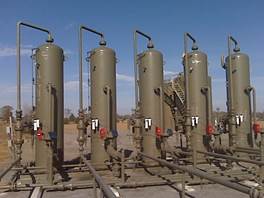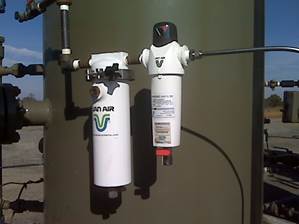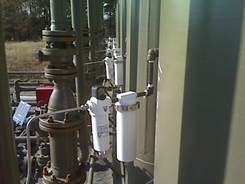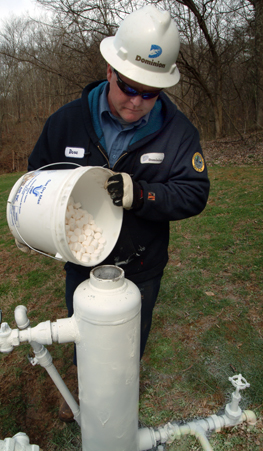Pipeline Natural Gas Dehydration Vessels
Van Gas Technologies specializes the dehydration of natural gas using deliquescent desiccants. Deliquescent desiccants are small tablets composed of various blends of hygroscopic chloride salts. These tablets have a strong affinity for water vapor and, when packed into a properly designed pressure vessel, are used to dehydrate a saturated stream of natural gas. This gas drying process requires no outside power supply or heat source and involves no moving parts. It is the simplest of gas of drying technologies and ideal for the dehydration of fuel gas, instrument gas, and small flows of sales gas.
If you have an application inquiry, first determine your operating pressure, temperature, and flow rate. Then contact us with a description of the gas dehydration application. Or call 800-840-9906 and ask to speak with Technical Sales.
Van Gas Technologies not only produces deliquescent desiccant tablets. We also fabricate a wide range of dryer vessels for use with GasDry deliquescent desiccants in natural gas dehydration applications. Our primary line of gas drying vessels is the PLD Series. From small fuel gas dryers to main line sales gas dryers, PLD Series dryers can be installed in a variety of natural gas dehydration applications.
The Pipeline Dryer (PLD) natural gas dryer is simple in design and simple to operate, with no moving parts or power requirements. PLD natural gas dehydration vessels are commonly used as fuel gas dryers or instrument gas dryers. In some cases, a PLD natural gas dehydration vessel can be used to replace a TEG dehydrator.
- Wet gas enters the natural gas dehydration vessel and contacts the pre-bed of ceramic bead. This layer collects mists and aerosols.
- Gas flows upward through the bed of GasDry deliquescent desiccant . The desiccant extracts humidity and gradually dissolves, i.e. deliquesces as gas dehydration takes place
- A brine solution gathers in the vessel sump area for draining and disposal
- Dehydrated natural gas exits the vessel
- New GasDry desiccant is periodically added to the vessel
- Unlike a TEG dehydrator, a PLD natural gas dehydration vessel has no pump or re-boiler
- Unlike a TEG dehydrator, a PLD natural gas dehydration vessel work well in low flow fuel gas and instrument gas applications
- Unlike a TEG dehydrator, a PLD natural gas dehydration vessel produces no emissions and consumes no fuel gas.
Standard features available with all PLD natural gas dehydration vessels include:
- 280, 720, or 1440 PSIG design pressure
- 8 – 36 inch vessel diameter
- Standard design flow rates up to 15.2 MMSCFD
- Built and stamped per ASME Code
- Quick access hammer union closure
- Float coupling for automatic dump system (except PLD8)
- CRN registration
Custom options:
- Vessel diameters greater than 36 inches
- Special paint requirements
- Multi-stage systems, pre-piped and skid-mounted
- Packaging of dump systems, controls, and instrumentation
- Inlet filter-separator
- Downstream dry gas particulate filter
- Integrated desiccant loading platform with ladder
See below images of small inline desiccant dryers protecting instrument gas lines on wellhead production separators.



Learn More
Pipeline Series Natural Gas Dryers
Pipeline Dryer Instruction Manual
Pipeline Dryer Instruction Manual
Pipeline Dryer Instruction Manual
Van Gas Technologies All Product Brochure



